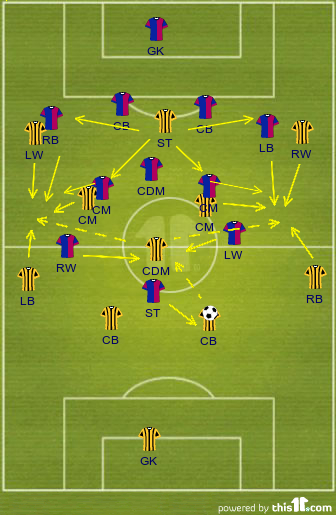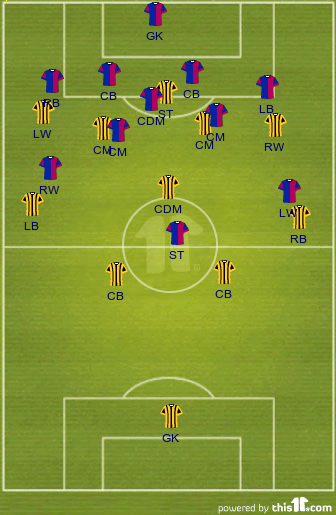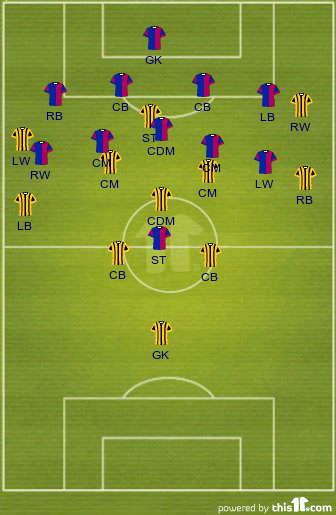Attack the Flanks
If you utilise the space on the flanks whilst attacking, you vary your build up since you add moves to the possible repertoire such as moving down the touchline and whipping in a cross, to cutting inside and taking a shot, this will make you much less predictable and therefore more difficult to defend against, even if the opposition pack their own area.
By making use of the wide areas of the pitch, no space is wasted and you can control all of the area around the penalty box, allowing you to put more pressure on the opposition team, and giving you an increased likeliness to create chances since you have more players in more space than if you attacked narrowly.
Another reason as to why increasing the width of the attack is almost a necessity for breaking down a compact defence is that you can open up the space in between the channels, effectively making the opposition's final third less dense with defenders. This is a technique used by Tito Villanova's Barcelona, who often position Isaac Cuenca and Pedro on the touchline, forcing the opposition to adjust to this and stretch their own defence wider, which gives Messi and Fabregas more space to use their great ability to orchestrate the attacks.
As you can see, the attacking side have sent their full-backs and wingers forward and hugging the touchline, which has dragged out both of the defending side's full-backs which has created more space in between said full-backs and their teammates at CB. The defending wingers have also been dragged wide, so there is more space to be taken advantage of by the attacking side's creative players.
Drop Deep Yourself
This seems like a very strange move if you're wanting to attack the opposition, however when they're denying you space within their penalty box, you need to create space in other areas of the pitch to utilise. When a team is pushing for a goal against a very defensive minded side, their defensive line is usually around the halfway line as they look to put pressure upon the opposition. However, this means that half of the pitch is wasted, with just the attacking side's 'keeper in the otherwise vacant half.
By dropping deep, the attacking side creates space within their own half which albeit isn't the most useful space being distant towards the opposition's goal, though it can drag the defending players out of their position.
 This diagram shows just how dropping deep can give your striker space to run into from the build-up play as the ball moves up field.
This diagram shows just how dropping deep can give your striker space to run into from the build-up play as the ball moves up field.We start with the centre-back in possession of the ball, he will almost certainly be closed down by the opposition striker, who then leaves the central defensive midfielder open to receive a pass behind him.
The two most likely people to press the holding midfielder who has just collected the ball are the two wingers, since the striker has just pressed the deep centre-back and both central midfielders are marking players. Should a winger close the CDM down then they, like the striker, leave space behind them which can be used by either the full-back, midfielder, or winger on the flank that he has passed it to. The best candidate to move into this space and collect the ball off of the defensive midfielder is the winger, because his movement deep could open the space for the striker that I mentioned earlier.
If the opposition full-back follows the winger who drops deep, then the space opens up for the striker to capitalise on and make a run in behind the defence to receive a through ball from either the CDM or the winger himself.
If the full-back doesn't follow on the other hand, then the winger will have enough space to pick up the ball, turn and have enough time to dribble towards the full-back and be at full pace by the time he meets him, it's a lose-lose situation for the full-back.
I created this .gif to try and show it better because I feel I didn't explain it very well in the text, If it's a good addition then tell me, I'll use .gifs more frequently in future articles if so give us a shout!
Send Midfielders Forward, but Keep a Regista Lying Back
 A mistake which is often made by teams desperately trying to find an equaliser is to throw the midfield forward into the opposition's box, but then still leave the side without a holding midfielder, which leaves them extremely vulnerable to a counter-attack. A regista can solve that problem, whilst being the playmaker who can sit behind the attacks and dictate the tempo.
A mistake which is often made by teams desperately trying to find an equaliser is to throw the midfield forward into the opposition's box, but then still leave the side without a holding midfielder, which leaves them extremely vulnerable to a counter-attack. A regista can solve that problem, whilst being the playmaker who can sit behind the attacks and dictate the tempo.
With their midfield deep in defensive work, the defending side often leave space ahead of the penalty box open though it is often forgotten about by the attacking side as they send all midfielders forward in search of that all important goal. A regista in this space could be vital to a side's attacks for many reasons; one, he can orchestrate the progression forward, two, he can intercept counter-attacking passes from the opposition giving your side more freedom, three, he can make the side play wide as talked about earlier by simply spraying passes to both flanks.
Thanks for reading guys! I decided not to include the simple things such as use substitutions since I don't think there is much point. Please give some feedback in the comments below, especially on the .gif diagram I included! You can follow me on Twitter, if you already are then maybe share the article to your followers? It'd be greatly appreciated!


GIF is an excellent addition Sir..
ReplyDeleteI like the gif. If you intend to use it more often, and I think it could be a great addition, then one thing I'd suggest is to number the frames (1/5, 2/5, 3/5 ...). Without a little annotation it might not always be clear what you're trying to show.
ReplyDeleteOkay thanks for the feed back guys!
ReplyDeleteFantastic post!
ReplyDelete